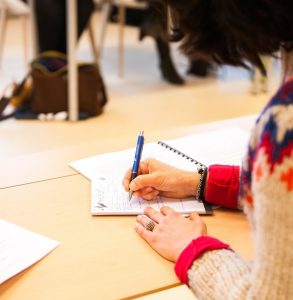Put to the Test
Learning Goals
In this chapter, you will learn to:
- Use pre-reading strategies
- Describe the tone of a text
- Build your vocabulary
- Understand the main ideas, details, and sequence of a text
- Make inferences
- Spell words with the prefixes pre- and ex-
- Use punctuation marks in direct quotations
- Write complex sentences

Get Ready to Read
Think about the questions below or discuss them with a partner.
- Agree or disagree: Tests should be banned from schools.
- What tips would you give to a friend who is about to take a test?
Think about the title Put to the Test. Which of these words do you think will be in the text?
| fridge | luck |
| underwear | tuba |
| eyelid | section |
| time | marathon |
| instructions | reading |
| Paris | writing |
Reading Strategy
Readers check their understanding of a text while they read. One strategy is to think about tone. Tone refers to the attitude of the writer. For example, a writer’s attitude can be playful, serious, happy, sad, supportive, or hurtful.
Try this strategy as you read Put to the Test. How would you describe the tone of this text? Why?
Vocabulary
Find these words in the text. Use the context to choose the best meaning.
| independent | plenty | enough | comprehension |
| temples | backup plan | marathon |
1. A running race that lasts a long time is called a ___________________________.
2. ___________________________ means the ability to understand.
3. ___________________________ means doing something without help.
4. ___________________________ means equal to what is needed.
5. ___________________________ means lots of something; a number of something that is enough.
6. Something that can be done if the first plan doesn’t work is called a ___________________________.
7. The small flat areas on the sides of your forehead are called ___________________________.
Check Your Understanding
1. Re-read paragraph three. What is the main idea of this paragraph?
2. Put these events in order.
a. Put your name on it.
b. Do your best on every question.
c. Make sure you answered every question and used correct grammar and spelling.
d. Take care of your basic needs.
e. Look over the whole test to see how many marks each section is worth.
f. Read the instructions and questions carefully.
g. Study the types of questions often found on reading and writing tests.

Answer these questions in complete sentences.
3. What sections in a test should you spend the most time on?
4. How is writing a test like running a marathon? How is it different?
5. What is positive self-talk?
6. The text strongly recommends doing two things that students often forget to do. What are the two things?
Make an inference to answer these questions. An inference is an educated guess.
7. Why do you think positive self-talk works?
8. Why do you think students often skip pre-reading and pre-writing exercises?
Spelling
Study these words. The prefix pre– means “before.” The prefix ex– means “out of” or “from.” Arrange a date to be tested on your ability to spell these words.
|
prepare preview prepaid preheat prefer |
example express excuse exercise |
One way to learn to spell new words is to look at one closely, cover it up, try to spell it, and then check it. Try this strategy below.
1. prepare _____________________________________________
2. preview _____________________________________________
3. prepaid _____________________________________________
4. preheat _____________________________________________
5. prefer _____________________________________________
6. example _____________________________________________
7. express _____________________________________________
8. excuse _____________________________________________
9. exercise _____________________________________________
Direct Quotations
Quotation marks are used to show that the words inside them are the exact words that someone said, thought, or wrote.
Below is an example from the text:
Some runners use positive self-talk when they are struggling. They tell themselves things like, “I feel good about myself and my abilities. I am not going to worry. I will do the best that I can.”
Notice that a comma follows the word right before the quotation. The end punctuation goes inside the last quotation mark.
Fill in the missing quotation marks, commas, and end punctuation in the sentences below.
1. A parrot named Alex was the first animal to ask a human a question about himself. Alex asked What colour am I
2. When Alex got bored of working with his trainer, he would say Wanna go back!
3. The night before Alex died, he spoke his last words to his trainer. He said Be good. Good night. I love you
4. Koko is a gorilla who can speak a form of American Sign Language. She knows about 1,000 signs and has the ability to create logical words for things she doesn’t know the name of. For example, for ring she said finger bracelet and for mask she said eye hat
5. There was a seal named Hoover who lived in an aquarium. Hoover said How are ya to some visitors. To other visitors he said Get outta here!
6. An elephant named Batyr learned 20 different phrases. He could say Batyr is good He could also say Batyr is hungry
Complex Sentences
Grammar Rule
- You have learned that a compound sentence is made by joining two complete sentences. On the other hand, a complex sentence is made by joining one complete sentence with a sentence fragment. Together, they make one complete sentence.
- You can put the two parts in whatever order you prefer. Below are two correct complex sentences:
- Before you hand in your test, you should review your answers.
or - You should review your answers before you hand in your test.
- Before you hand in your test, you should review your answers.
- Both sentences are made of a sentence fragment (“Before you hand in your test”) and a complete sentence (“You should review your answers”).
- If you put the fragment first, follow it with a comma. If you put the fragment last, do not use a comma.
- Fragments often begin with one of these words:
| after | although | as | because |
| before | even if | even though | if |
| in order to | since | so that | unless |
| until | when | while |
Read each complex sentence below. Insert commas as needed. Remember that not all complex sentences need a comma.
1. If you want breakfast in bed you should sleep in the kitchen.
2. To escape a black hole you must go faster than the speed of light.
3. After a spider web has collected dust it becomes a cobweb.
4. The Ski-Doo cost $900 when it first came out in the 1950s.
5. Until 1920 people in British Columbia drove their cars on the left side of the road.
Look at the sentence fragments below. Use your own ideas and the rules you have learned to turn them into complex sentences.
1. If you want to wake someone up really quickly.
2. When riding on the bus.
3. When I was five years old.
4. Until the day I die.
5. Before you buy a lottery ticket.
Look at the complete sentences below. Use the word in brackets and your own ideas to turn them into complex sentences.
1. I love long car rides. (unless)
2. A dog can be a person’s best friend. (although)
3. I was about to pay the bill. (when)
4. I filled the birdfeeder with seeds. (before)
5. The seal watched me from the water. (while)
Writing
Writing Task
Life tests us in many ways. There are school tests, drivers’ tests, and job interviews. Then, there are situations that test our patience, our love, our loyalty, and our beliefs. What words of wisdom and encouragement have helped you make it through life’s tests? Fill in the Inspiring Words worksheet. Use quotation marks correctly.
Ask your instructor for a copy of the worksheet, or print one from the link above. For a printable version, see Appendix 1.
Answer Key
| Vocabulary | |
| QUESTION | ANSWER |
| 1 | marathon |
| 2 | comprehension |
| 3 | independent |
| 4 | enough |
| 5 | plenty |
| 6 | backup plan |
| 7 | temples |
| Check Your Understanding | |
| QUESTION | ANSWER |
| 1 | Take care of your basic needs before the test begins. |
| 2 | g, d, a, e, f, b, c |
| 3 | Spend the most time on questions that are worth the most marks. |
| 4 | Writing a test is like running a marathon because you have to do your best over a long period of time. It is different from a marathon because it does not matter who finishes first. |
| 5 | Positive self-talk is when you tell yourself things that help you feel good and do your best. (Your explanation may use different words to make the same point.) |
| 6 | The text recommends doing pre-reading and pre-writing exercises. |
| 7 | Answers may vary. Example: Positive self-talk might work because it builds confidence so that we can focus on what we are doing. It helps put an end to negative thoughts about ourselves that can feel distracting and overwhelming. |
| 8 | Students probably skip pre-reading and pre-writing exercises because they think it will save them time. |
| Direct Quotations | |
| QUESTION | ANSWER |
| 1 | A parrot named Alex was the first animal to ask a human a question about himself. Alex asked, “What colour am I?” |
| 2 | When Alex got bored of working with his trainer, he would say, “Wanna go back!” |
| 3 | The night before Alex died, he spoke his last words to his trainer. He said, “Be good. Good night. I love you.” |
| 4 | Koko is a gorilla who can speak a form of American Sign Language. She knows about 1,000 signs and has the ability to create logical words for things she doesn’t know the name of. For example, for ring she said, “finger bracelet” and for mask she said, “eye hat.” |
| 5 | There was a seal named Hoover who lived in an aquarium. Hoover said, “How are ya?” to some visitors. To other visitors he said, “Get outta here!” |
| 6 | An elephant named Batyr learned 20 different phrases. He could say, “Batyr is good.” He could also say, “Batyr is hungry.” |
| Complex Sentences | |
| QUESTION | ANSWER |
| 1 | If you want breakfast in bed, you should sleep in the kitchen. |
| 2 | To escape a black hole, you must go faster than the speed of light. |
| 3 | After a spider web has collected dust, it becomes a cobweb. |
| 4 | The Ski-Doo cost $900 when it first came out in the 1950s. |
| 5 | Until 1920, people in British Columbia drove their cars on the left side of the road. |
Attributions
Writing
Image by aafjevandehulsbeek is in the public domain.
Runner
Image by tpsdave is in the public domain.

